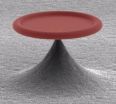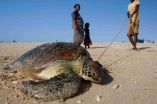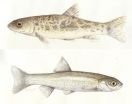New analysis explains formation of bulge on far side of moon
2010-11-12
(Press-News.org) SANTA CRUZ, CA--A bulge of elevated topography on the farside of the moon--known as the lunar farside highlands--has defied explanation for decades. But a new study led by researchers at the University of California, Santa Cruz, shows that the highlands may be the result of tidal forces acting early in the moon's history when its solid outer crust floated on an ocean of liquid rock.
Ian Garrick-Bethell, an assistant professor of Earth and planetary sciences at UC Santa Cruz, found that the shape of the moon's bulge can be described by a surprisingly simple mathematical function. "What's interesting is that the form of the mathematical function implies that tides had something to do with the formation of that terrain," said Garrick-Bethell, who is the first author of a paper on the new findings published in the November 11 issue of Science.
The paper describes a process for formation of the lunar highlands that involves tidal heating of the moon's crust about 4.4 billion years ago. At that time, not long after the moon's formation, the crust was decoupled from the mantle below it by an intervening ocean of magma. As a result, the gravitational pull of the Earth caused tidal flexing and heating of the crust. At the polar regions, where the flexing and heating was greatest, the crust became thinner, while the thickest crust would have formed in the regions in line with the Earth.
This process still does not explain why the bulge is now found only on the farside of the moon. "You would expect to see a bulge on both sides, because tides have a symmetrical effect," Garrick-Bethell said. "It may be that volcanic activity or other geological processes over the past 4.4 billion years have changed the expression of the bulge on the nearside."
The paper's coauthors include Francis Nimmo, associate professor of Earth and planetary sciences at UCSC, and Mark Wieczorek, a planetary geophysicist at the Institut de Physique du Globe in Paris. The researchers analyzed topographical data from NASA's Lunar Reconnaissance Orbiter and gravitational data from Japan's Kaguya orbiter.
A map of crustal thickness based on the gravity data showed that an especially thick region of the moon's crust underlies the lunar farside highlands. The variations in crustal thickness on the moon are similar to effects seen on Jupiter's moon Europa, which has a shell of ice over an ocean of liquid water. Nimmo has studied the effects of tidal heating on the structure of Europa, and the researchers applied the same analytical approach to the moon.
"Europa is a completely different satellite from our moon, but it gave us the idea to look at the process of tidal flexing of the crust over a liquid ocean," Garrick-Bethell said.
The mathematical function that describes the shape of the moon's bulge can account for about one-fourth of the moon's shape, he said. Although mysteries still remain, such as what made the nearside so different, the new study provides a mathematical framework for further investigations into the shape of the moon.
"It's still not completely clear yet, but we're starting to chip away at the problem," Garrick-Bethell said.
###
END
ELSE PRESS RELEASES FROM THIS DATE:
2010-11-12
ANN ARBOR, Mich.---Strategies for preventing the spread of whooping cough---on the rise in the United States and several other countries in recent years---should take into account how often people in different age groups interact, research at the University of Michigan suggests.
The findings appear in the Nov. 12 issue of the journal Science.
Thanks to widespread childhood vaccination, whooping cough (pertussis) once seemed to be under control. But the illness, which in infants causes violent, gasping coughing spells, has made a comeback in some developed countries ...
2010-11-12
Boston, Mass. - While it has become clear in recent years that susceptibility to pain has a strong inherited component, very little is known about actual "pain genes" and how they work. In the November 12th issue of Cell, researchers at Children's Hospital Boston and their collaborators report on a novel human pain gene. People with minor variations in this gene showed clear differences in susceptibility to acute heat pain and chronic back pain. Corroborating mouse studies give some clues as to how the gene controls pain sensitivity. The gene was uncovered in a genome-wide ...
2010-11-12
Controlling and modulating the flow of light is essential in today's telecommunications-based society. Professor Tobias Kippenberg and his team in EPFL's Laboratory of Photonics and Quantum Measurements have discovered a novel way to couple light and vibrations. Using this discovery, they built a device in which a beam of light traveling through an optical microresonator could be controlled by a second, stronger light beam. The device thus acts like an optical transistor, in which one light beam influences the intensity of another.
Their optical microresonator has two ...
2010-11-12
Individuals who suffer from severe acne are at an increased risk of attempting suicide, according to a paper published on bmj.com today.
The study also finds that an additional risk may be present during and up to one year after treatment with isotretinoin, a commonly prescribed drug for severe acne. However, the authors stress that this additional risk is most likely due to the acne itself, rather than the drug treatment.
Isotretinoin (commonly marketed as Roaccutane, Accutane, Amnesteem, Claravis, Clarus or Decutan) has been used to treat severe acne since the 1980s. ...
2010-11-12
New research has revealed up to 16,000 endangered turtles are being caught each year by villagers in just one region of Madagascar, despite a government ban.
Researchers from the University of Exeter and Blue Ventures Conservation say the figure, thought to be a conservative estimate, is the first direct assessment of turtle exploitation on the island.
The study highlights the extent of small-scale fishing, traditionally very difficult to monitor, and could be vital in finding a way to sustainably manage turtle fishing in the region.
Dr Annette Broderick, from the ...
2010-11-12
"The biggest surprise to me was that we could rescue the autistic phenotype [in the human cells] to something close to normal," said Alysson Muotri of the University of California San Diego.
The researchers made the discovery by first transforming adult cells taken from patients with Rett Syndrome into induced pluripotent stem cells (iPS cells) using an established cocktail. iPS cells look and act very much like embryonic stem cells.
Those stem cells were able to form functional neurons in cell culture. However, neurons derived from Rett Syndrome patients exhibited ...
2010-11-12
They show that one of those genes in particular has a long evolutionary history, as evidenced by the fact that it plays a role in pain sensing in flies, mice and humans. At least in mice, the newly described gene is also linked to a condition known in humans as synesthesia, in which one sensory experience triggers the perception of another sense.
"We found lots of new genes and pathways that have never been implicated in pain before," said Josef Penninger of the Institute of Molecular Biotechnology of the Austrian Academy of Sciences.
"From a helicopter view, this ...
2010-11-12
Night-time violence among young Spaniards is becoming ever more common, according to a research study carried out by the European Institute of Studies on Prevention. The study shows that 5.2% of young people carry weapons when they go out at night, 11.6% have been attacked or threatened, and 23% have got into a fight at some time.
"Reports about young people being attacked or injured in fights when they go out at night are becoming increasingly common", Amador Calafat, lead author of the study and a researcher at the European Institute of Studies on Prevention (IREFREA), ...
2010-11-12
An international team led by the Forest Technology Centre of Catalonia has carried out the first large-scale study of the threats facing freshwater fish in the Mediterranean basin. Invasive species, along with over-exploitation of water resources, are the most important pressures, and those that expose fish to the greatest risk of extinction.
"The continental fish of the Mediterranean basin are one of the most threatened biological groups in the world", Miguel Clavero, lead author of the study and a researcher from the Landscape Ecology Group of the Forest Technology ...
2010-11-12
After four years of conducting intensive calculations in the supercomputer MareNostrum at the Barcelona Supercomputing Center, scientists headed by Modesto Orozco at the Institute for Research in Biomedicine (IRB Barcelona) have presented the world's largest data base on protein motions. Called MoDEL, this new database holds more than 1,700 proteins and is partially accessible through Internet to researchers worldwide. MoDEL has been developed to study the basic biology of proteins and to accelerate and facilitate the design of new pharmaceutical agents.
"Nowadays we ...
LAST 30 PRESS RELEASES:
[Press-News.org] New analysis explains formation of bulge on far side of moon



